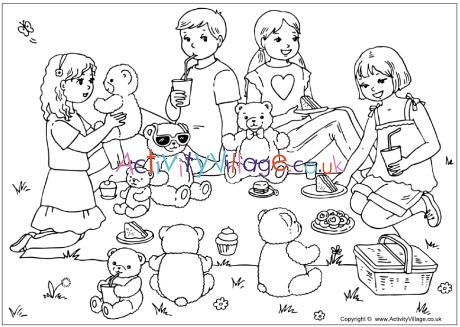In this British card game, likely inspired by the children's song, everyone tries to get 10 teddy bears to come to his/her picnic. 54 cards show teddy bears, honey pots, food items and other objects. Drag and drop sorting games. You need to sort the three bears clothing and food according to size.This site works well on an interactive whiteboard and provides an opportunity for learning maths vocabulary about size. Everyone has a favourite teddy bear, and everyone loves a teddy bears picnic. And this printable teddy bear picnic game map is perfect for children's parties and bear hunts! Guaranteed to add maximum cuteness to your child's birthday party - just don't forget to bring a teddy bear! ️ PERSONALISATION?
This is a very simple game that serves as a good introduction to game playing for children as young as 3 years of age.
The game was designed around small plastic teddy bears in three different colors that a teacher found for sale at a craft store. The teacher then designed the game around the theme of the teddy bears' picnic, using the teddy bears as playing pieces. Similar games could be designed to fit the theme of any small playing pieces.
Teddy Bears Picnic Game Ideas
The game can be played competitively or cooperatively. However, in all versions, the competition is downplayed in the wording of the objective to get all of the teddy bears back to the picnic. The rules refer to the teddy bears winning, rather than the players. The competitive version has several variations.
Cooperative Version
The cooperative version of this game (see Teddy Bears' Picnic rules—cooperative) resembles the classic Ravensburger game Snail's Pace Race. Children play with one game board (with 3 paths, one for each teddy bears), 3 teddy bears, and a die with one colored dot on each face (corresponding to the colors of the hives and paths). Children simply take turns rolling the die and moving the correct teddy bears one space on its path. Each path consists of only 7 spaces in a straight line, so the game moves relatively quickly.
Children do not win or lose this game; teddy bears do. The teddy bears that gets to its bee at the end of its path first is the winner. Children often enjoy predicting which teddy bears will get to the end first.
This game helps children learn the basics of game playing such as taking turns and following simple rules. Each teddy bear moves only one space at a time. This can help combat the common error that young children often make in path games in which they count the space they start on as 'one' and therefore always end up moving one fewer spaces than the number they rolled.
Competitive Version
Best roulette numbers to play. This game can be played competitively either with children having their own game boards, or with all children using one game board.
In the basic version, children each have their own game board that they use to move one teddy bear from start to the picnic at the end of the path. Giving players their own game board helps in reducing the number of challenges children must coordinate. Children do not have to deal with problems such as bumping another player off a space or forgetting which teddy bear is theirs.
Different types of individual game boards are included. The easy version has 9 spaces in a straight line and the hard version has 25 spaces with 4 right-angle turns. In the one-board version (using the same board as the cooperative version), players each place their teddy bear on its matching path and move their teddy bears along that one path from start to the picnic at the end. Giving children their own path on the board avoids the problem of having 2 bears land on the same space.
Children can use a standard die with the numbers 1-6, although another die with smaller numbers can also be used. Especially if the easy game board with only 9 spaces is used, a die with smaller numbers is recommended. A die can be made with two each of the numbers 1-3, or other configurations of numbers (such as three 1s, two 2s, and one 3). If children frequently make the error mentioned above of counting the space their teddy bears is occupying as 'One' and then moving ahead (thus moving one fewer spaces than the number that was rolled), a die with smaller numbers can be very helpful in creating a feeling of contradiction as the children roll 'one' and do not move. This feeling of contradiction can prompt them to revise how they count the spaces.
Teddy Bears Picnic Game Rules
Recommended # of players: 2 - 3
The Teddy Bear Picnic Lyrics

Click here to download the game.

